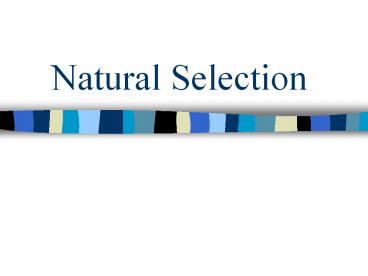Natural Selection - PowerPoint PPT Presentation
Title:
Natural Selection
Description:
Natural Selection Today s Objectives: SOL BIO.8b-d TSW investigate and understand how populations change through time, including: How variation of traits ... – PowerPoint PPT presentation
Number of Views:36
Avg rating:3.0/5.0
Title: Natural Selection
1
Natural Selection
2
Todays Objectives SOL BIO.8b-d
- TSW investigate and understand how populations
change through time, including - How variation of traits, reproductive strategies,
and environmental pressures impact on the
survival of populations - Recognizing how adaptations lead to natural
selection - How new species emerge
3
Charles Darwin
- On the Origin of Species
- Sailed with the HMS Beagle
- Observations made in the Galapogos Islands
- These observations helped him form the theory of
how species change over time called natural
selection
4
What is Natural Selection?
- Natural selection is governed by the principles
of genetics.
5
Types of Adaptations
- Protective Coloring
- Camouflage
- Mimicry
- Physiological Adaptations
- Reproductive Changes
- Other changes
- Behavioral Adaptations
6
Evidence for Evolution
- Fossil record
- Anatomy
- Homologous structures
- Analagous structures
- Vestigial structures
- Embryology
- Molecular biology (DNA differences)
7
What is a Population?
- Populations evolve over many generations,
individuals dont - Populations are groups of interbreeding
individuals that live in the same place at the
same time - Individuals in a population compete for resources
with each other
8
How Does Evolution Work?
- Populations produce more offspring than the
environment can support - The unequal ability of individuals to survive and
reproduc leads to the gradual change in a
population over many generations
9
Mechanism for change in a population of organisms
- Animals who have greater fitness survive in
environment and live to reproduce - Random changes (mutations) can lead to greater or
less fitness - Adaptations allow an organism to survive better
in their environment
10
Mutations Variety Produced by Sexual
Reproduction Allow for Diversity within a
Population
- Genetic drift (caused by chance)
- Bottleneck
- Founder effect
- Genetic equilibrium
- Hardy-Weinberg law
- In H-W equilibrium, does not occur
11
Adaptations
- Can arise in response to environmental pressures
- Temperature
- Antibiotic resistance in bacteria
- Pesticide resistance
- Morphological changes in peppered moths
12
Types of Selection
- Directional
- Extreme form favored by natural selection
- Stabilizing
- Middle form most successful
- Disruptive
- Two extreme forms successful in separate
environments
13
How are new species created?
- Geographic isolation
- Reproductive barriers
- Change in chromosome numbers
- Adaptive radiation
14
Types of Evolution
- Convergent evolution
- Dolphins fishes
- Wings of bees bats
- Divergent evolution
- Darwins finches
- Adaptive radiation
15
How fast does evolution occur?
- Gradualism
- Darwin
- Species change slowly over time
- Punctuated Equilibrium
- Gould Lewontin
- Species can make rapid leaps in evolution
- Modern Synthesis
- Parts of both are correct































